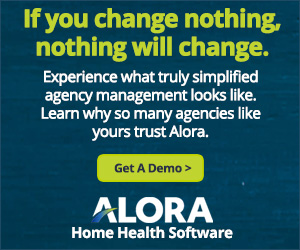
27 Nov Home Health Agency Safety Goals
Do Your Agency Safety Goals Align with the CMS Quality Strategy?
The list of potential goals to support a successful home health agency is exhaustive. Goals can be long-term or short-term, related to financials, safety, service, and quality, or created primarily surrounding imposed regulations. Deciding the most important areas to focus on is nonetheless a difficult process as leaders are determining where to allocate resources.
The 2022 National Quality Strategy (NQS) initiative by the Centers for Medicare and Medicaid Services (CMS) offers home health agency leaders some insight and direction in creating goals to align with their national priorities for healthcare organizations. There are four priority areas:
- Outcomes and Alignment
- Equity and Engagement
- Safety and Resiliency
- Interoperability and Scientific Achievement
A supplemental document released in April of 2024, “Quality in Motion,” explains how CMS is acting on the quality goals through collaboration and partnerships to promote the success of the NQS. Agencies can use actions within their organization as they apply to their patient populations and communities to achieve goals in these areas. As CMS continues to define and develop data collection to determine outcomes of nationwide goals, agencies could potentially benefit by reducing their reporting burden and improving their agency.
Safety Goals
 Of the four listed priority areas within the NQS, safety is highlighted in a November CMS Safety Spotlight. Patient safety is still a major concern in healthcare. Disparities, inequities, and fragmented care contribute immensely to poor patient outcomes.
Of the four listed priority areas within the NQS, safety is highlighted in a November CMS Safety Spotlight. Patient safety is still a major concern in healthcare. Disparities, inequities, and fragmented care contribute immensely to poor patient outcomes.
Home health agencies can promote their reputation and dedication to patients by aligning their organization’s safety goals and strategies in several ways to align with the national initiative. The CMS identifies three means to improve safety for all. This includes implementing transparent care, the use of collaborative partnerships, and implementing a culture of safety.
Transparency
Sharing information between all parties involved in a patient’s care is the cornerstone of transparency. Why should agencies care? Having transparency in your organization promotes public trust, and reduces breakdowns in communication on procedures, scheduling, complications, concerns from staff, concerns from the patient or family, and much more. To set a goal to promote transparency in your agency, first consider your answers to the following questions:
- Do staff members report having adequate time for in-home visits to fully explain the plan of care, patient and staff expectations, therapy risks, and benefits of in-home care?
- Is information shared with patients at their educational level, in the format in which they best understand?
- Can staff easily share updates on patient status with the ordering provider? Does your agency utilize home health software that promotes interoperability, or is there a cumbersome process involving aged techniques and room for human error in information sharing?
If you have several “no” answers to the above questions, transparency may be a good place to create a goal for your agency. The Institute for Healthcare Improvement, through the experience and research of physician Thomas Gallagher, suggests five Ways to Advance Transparency in Healthcare such as:
- Use of “bundles” for communications: Create standards of practice (SOPs) for staff about communication with providers, patients, and other stakeholders. Ensure all have access to communications so they can refer to others’ notes easily for verification of information if needed.
- Promote emotional intelligence in communications: Provide resources for staff on how to approach sensitive situations without projecting judgment or a closed mind. Educate staff on specific ways to use empathy and reserve bias when communicating problems. Ensure leadership withholds negative assumptions when staff bring forward concerns.
- Utilize tried and true programs such as the Communication and Resolution Program or Communication and Optimal Resolution (CANDOR) or implement their resources to address your agency’s follow-up protocols for when adverse events happen to patients under your care.
A Culture of Safety
Organizations should promote safety through the implementation of a just culture that highly benefits both staff and patients. It has been reiterated for over 20 years that to err is human and healthcare workers are not intentionally causing patient harm, rather broken systems are often to blame. Leaders in home health can role model a culture of safety by creating organizational goals promoting patient and worker safety. If patients and employees feel comfortable enough to speak up about concerns without retaliation, organizations can better identify areas of improvement and prevent more serious problems down the road. Some ideas to promote a culture of safety in home health include:
- Promoting healthcare worker environment safety through the use of a third-party company for an escort if needed to a home visit or availability of an emergency app if the healthcare worker feels their personal safety is threatened.
- Allowing patients access to their documented notes regarding care communication to facilitate any needed conversations to address gaps in care.
- Implement principles of high-reliability organizations such as remaining aware of potential safety concerns and identifying near misses, creating standardized workflows and explaining the “why” related to processes, ensuring team members understand others’ roles in the organization and function in patient care vs. only their role.
Once organizational goals are set, celebrating small milestone achievements can propel your organization to meet and potentially exceed the overall expectations. Goals should be well constructed, directly applicable, and achievable by the agency. Familiar ways to structure goals include the use of SMART principles: Specific, Measurable, Achievable, Realistic,c and Timely. No agency can attack all priority areas at once, however, making progress aligning with at least some of the national NQS goals can set the agency up for success today and in the future.
Helpful links:
- November CMS Safety Spotlight
- CMS 2022 National Quality Strategy (NQS initiative
- CMS Quality in Motion
- Five ways to enhance transparency in healthcare
- Communication and Resolution Program
- Communication and Optimal Resolution (CANDOR)
- High-Reliability Organizations
Author’s Note: Views, information, and guidance in this resource are intended for information only. We are not rendering legal, financial, accounting, medical, or other professional advice. Alora disclaims any liability to any third party and cannot make any guarantee related to the content.
Related blogs:

Alora’s home health software solution is ideal for agencies operating in both skilled and non-skilled care. Managing workflow for administrative and caregiving staff becomes easier with the right technology tools. Alora has been engineered with the goal of simplification of day-to-day tasks in the office and in the field, allowing agencies to focus on patient care, workflow efficiency, and growth.



No Comments